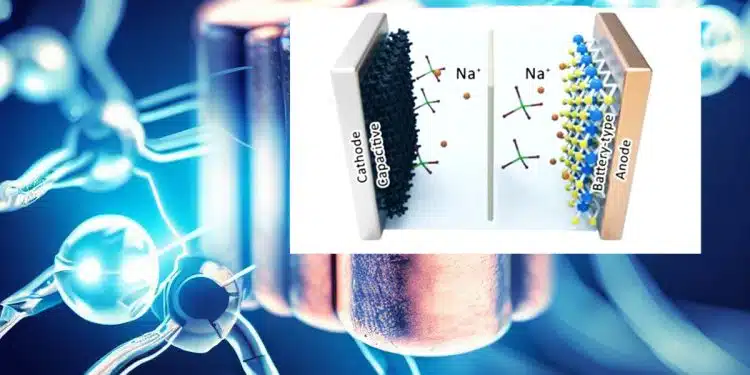Sodium ion supercapacitors (SICs) are among the most sought-after energy storage devices due to their characteristic high-power density together with long cycle life. Researchers from Nigeria investigates the emerging use of titanium-based materials as electrode component in sodium ion supercapacitors.
Sodium ion capacitor technology is trending but there are some challenges offered by the existing electrode materials. The transition metal compounds are widely explored as active electrode materials for SICs and titanium-based materials seem to exhibit outstanding potentials.
The high theoretical capacity, excellent electronic conductivity, long cycle life, and favorable sodium ion diffusion characteristics are some of the properties offered by titanium-based materials which qualify them as high-quality electrode materials. This work is pertinent as it guides the creation and selection of unconditional electrode materials for upcoming energy technologies.
In recent times, researchers are focusing lately on different techniques that will improve the turnout of the electrode electrochemical performance of supercapacitor cells. The idea is to, develop an efficient, affordable and environmentally friendly high-performance supercapacitors electrode materials using naturally bountiful resources/materials.
The interest in sodium ion capacitors is because sodium is the sixth most plentiful elements across the universe and its resources, like seawater, are inexpensive. There are reports on sodium ion capacitors, which uses sodium ions as their positive charge carrier and have been successful as energy storage technologies. The capacity of sodium ion capacitors to efficiently include both the substantial energy density of rechargeable batteries as well as the double-electric-layer capacitors high-power density is another interesting feature of this technology. This can be linked to the hybrid capacitors’ reversible anion adsorption/desorption together with a reversible Na ion insertion/desorption taking place on the cathode surface and on the anode respectively, as its charge storage methods. Furthermore, the sodium ion capacitors exhibit a greater energy density value than contemporary supercapacitor due to the battery-type anode’s faradaic response and higher power densities than batteries as a result of the cathodic capacitive reaction.
In spite of the fact that great efforts have been made to design workable SICs that has consistent cycle performance, high energy/power density, yet success relating to this area is still to be maximally achieved. There is difficulty of rapidly storing significant numbers of Na ions in a stable and reversible manner between a fast non-Faraday anode and a slow-moving Faraday anode. There is also no accessible and affordable anode that can bridge the kinetic mismatch and overcome the capacitive cathode, except through abridging the length of the Na+ diffusion while also through rational electrode fabrication, speed up Na+ transport.
In view of this proposed solution to the major challenge of SICs, several metal oxide composite materials, to a very large extent the materials based on Ti have been effectively investigated as a candidate for SICs electrode materials. This application is majorly as a result of Na+ been able to be inserted reversibly into the anchor design along with the Ti4+/Ti3+ redox reaction. As one of the rock-forming components, broadly dispersed within the earth’s crust, that is steady and nontoxic, the titanium-based compounds from reports show fabulous sodium storage performance and capacity execution. They could as a result appear to be guaranteed as high-performance electrodes for practical batteries and capacitors of sodium ion systems.
The development of appropriate anode materials is critical to the overall performance and viability of sodium-ion capacitors. Anode materials have an important role in determining the performance of SICs. The ideal anode material should have high specific capacity, good rate capability, long cycle life, low cost, and environmental sustainability. Among the various anode materials, titanium-based compounds have emerged as promising candidates for the anode materials due to their unique properties, including;
- Titanium being abundant and cost-effective, making it readily available for anode materials
- Ti-based materials exhibit good structural stability, contributing to their long cycle life
- Additionally, Ti-based compounds, such as TiO2, TiS2, and TiNb2O7, offer a wide range of options for optimizing performance
- Ti-based materials typically exhibit low operating voltages [53,54], contributing to the overall safety and energy efficiency of SICs
- Finally, titanium-based materials are environmentally friendly and do not pose any significant environmental hazards, making them a sustainable alternative to other anode materials that may have toxic or hazardous effects
Summary
Titanium-based materials have emerged as prospective electrode materials in sodium-ion capacitors due to their high conductivity, excellent mechanical properties, and ability to intercalate sodium ions. These materials have high-rate performance, excellent specific capacitance, with cycling stability, the plentitude of titanium in the Earth’s crust and its cheap cost make it an attractive alternative to other transition metal compounds used in electrode materials.
While there is still a need for further research to upgrade these materials conductivity and specific capacity, one other major advantage of using titanium-based materials is their ability to accommodate the large sodium ions in their crystal structure, which is necessary for high-capacity storage of sodium ions. The improvement of large-scale energy storage systems especially for sodium ion capacitors could be achieved when excellent electrode materials are obtained. The surface engineering, doping and composite formation of titanium based materials is trending and may circumvent the current challenges with fabricating electrode materials for SICs.
Read the full paper:
- Titanium materials as novel electrodes in sodium ion capacitors
- Author: Edwin U. Onoh,Elias E. Elemike,I.S. Ike,Emeka E. Oguzie
- Publication: Journal of Energy Storage
- Publisher: Elsevier
- https://doi.org/10.1016/j.est.2023.108061































